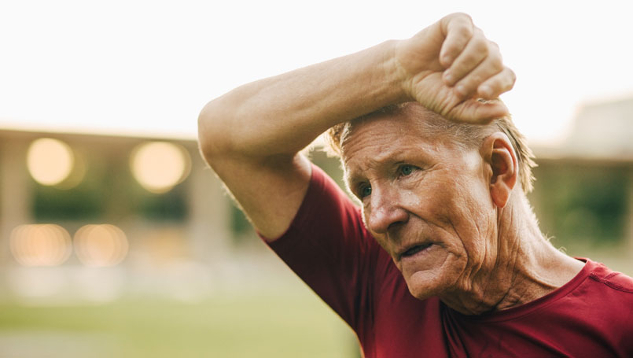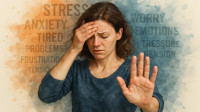
In This Article
- What are the warning signs of heat exhaustion before it’s too late?
- How does cloudy vision signal a critical heat-related danger?
- Why even healthy or younger people are at risk in hot weather
- What separates heat exhaustion from full-blown heat stroke?
- How can you prepare and protect yourself in extreme temperatures?
When the Heat Took My Vision: A Firsthand Warning About Heat Exhaustion
by Robert Jennings, InnerSelf.comI was working on the land—nothing too intense. I walked, checked for future pine planting, and considered structuring a few homestead plots. It wasn’t the first hot day of the season, but it was one of those deceptive ones. The kind where the sun sneaks up on you like a politician making promises, and you realize—too late—you’ve been had. That’s when the dizziness set in. Then, the fatigue. Then, my vision went cloudy. I’d never felt anything like it and had my fair share of close calls. This was different. This wasn’t just being tired or dehydrated. This was a total systems warning. A red light flashed from somewhere deep inside.
Cloudy Vision and the Silent Siren
We don’t talk enough about cloudy vision as a symptom. But it’s real. And terrifying. One moment, I was upright and fine; the next, everything in front of me turned hazy, like someone had smeared Vaseline across my glasses. I wasn’t wearing any. That’s how you know something’s wrong. When your body starts cutting power to non-essential systems—like sight—just to keep your heart and brain online, it’s time to stop and listen. Except most of us don’t. We push through. We say, “Just a little longer,” or “I’ll get some water in a minute.” That’s when people die.
Now, I’m not 25 anymore. I know age plays a role. The body’s internal thermostat isn’t what it used to be. But this isn’t just about age. Heat exhaustion doesn’t care if you’re young, ripped, or marathon-trained. All it needs is a little neglect. A missed water break. Too much sun exposure. Just enough exertion to tip the balance. And while walking a few acres, I saw young roofers, landscapers, and even high school athletes drop in far cooler temps—because they pushed too hard. Age makes you cautious. Youth makes you reckless. Heat exploits both.
The Danger Line: Heat Exhaustion vs. Heat Stroke
Let’s get technical for a moment. Heat exhaustion is the body screaming, “Cool me down now or pay the price.” Symptoms? Dizziness, fatigue, nausea, muscle cramps, heavy sweating, and—you guessed it—cloudy vision. If untreated, it turns into heat stroke. That’s when your internal temperature spikes above 104°F, your body stops sweating, your skin feels hot and dry, and confusion sets in. At that point, you’re not negotiating. You’re minutes from collapse—or worse. And no, popping into the shade for five minutes doesn’t fix it. Once your core temperature rises, it takes a real plan to restore it, which includes immediate cooling measures such as moving to a shaded area, removing excess clothing, and applying cool water or ice packs to the body.
We have this Hollywood image of people collapsing under the desert sun, parched and hallucinating. But heat exhaustion doesn’t need a desert. It just needs humidity and ignorance. You can be in Florida on a day that looks tame on the thermometer and still go down. Especially if you’re not hydrated, not rested, or not heat-acclimated. Heat acclimation is the process of gradually exposing your body to heat over a period of weeks, allowing it to adapt and become more efficient at cooling itself. Most people don’t realize that heat acclimation takes weeks, not days. You can’t go from air conditioning to full sun with a shovel in your hand and expect your body to handle it. That’s like sending a couch potato to Everest Base Camp and saying, “Take a hike.”
The Warning Signs I Ignored
Looking back, the signs were there. I had been sweating more than usual. I felt sluggish but brushed it off as normal heat. I had a dry mouth but figured I’d get water later. And then the vision went. That was the wake-up call. And frankly, it scared me. Because if that moment had come while I was using equipment, climbing, or even just in the wrong spot without shade nearby, the outcome could’ve been worse. Much worse. We don’t like to talk about our vulnerabilities. But this one’s worth shouting about.
I will now take water breaks like clockwork. Not when I’m thirsty—when I’m working. I wear a wide-brimmed hat even when it feels unnecessary. I pace myself. I check the forecast not for rain but for humidity and “feels like” temps. And I now treat heat like a real adversary. Not a nuisance. Not an inconvenience. A real, living threat that must be respected. If it can sneak up on me in my backyard, it can sneak up on anyone. Especially those who think they’re too harsh, fit, or young to worry about. I've also learned the importance of electrolyte replenishment and carry a supply of sports drinks or electrolyte tablets to maintain my body's balance during intense work in the heat.
This Is the New Normal
We’re entering a time when heat waves are longer, more intense, and less forgiving. Climate change isn’t theoretical anymore—it’s right there, dripping off your forehead and blurring your vision. And if we’re going to work outdoors, farm, build, or even take a summer walk, we’ve got to wise up. Knowing your body’s limits isn’t a weakness. It’s wisdom. It might also be survival. That moment of dizziness or cloudy vision isn’t just discomfort. It’s a final warning before your system shuts down—and the reboot may never come.
Some experiences don’t just shake you. They recalibrate you. This was one of them. I’m grateful it didn’t go further. But it reminded me how fragile the line is between “fine” and “fallen.” That line can appear in a heartbeat, especially under a hot sun. The lesson? Don’t wait for your vision to go. Don’t wait for the earth to tilt. Respect the heat. Know your limits. Hydrate early and often. And never, ever assume you’re immune. Heat exhaustion isn’t a myth. I’ve met it—and it nearly took me down.
About the Author
 Robert Jennings is the co-publisher of InnerSelf.com, a platform dedicated to empowering individuals and fostering a more connected, equitable world. A veteran of the U.S. Marine Corps and the U.S. Army, Robert draws on his diverse life experiences, from working in real estate and construction to building InnerSelf with his wife, Marie T. Russell, to bring a practical, grounded perspective to life’s challenges. Founded in 1996, InnerSelf.com shares insights to help people make informed, meaningful choices for themselves and the planet. More than 30 years later, InnerSelf continues to inspire clarity and empowerment.
Robert Jennings is the co-publisher of InnerSelf.com, a platform dedicated to empowering individuals and fostering a more connected, equitable world. A veteran of the U.S. Marine Corps and the U.S. Army, Robert draws on his diverse life experiences, from working in real estate and construction to building InnerSelf with his wife, Marie T. Russell, to bring a practical, grounded perspective to life’s challenges. Founded in 1996, InnerSelf.com shares insights to help people make informed, meaningful choices for themselves and the planet. More than 30 years later, InnerSelf continues to inspire clarity and empowerment.
Creative Commons 4.0
This article is licensed under a Creative Commons Attribution-Share Alike 4.0 License. Attribute the author Robert Jennings, InnerSelf.com. Link back to the article This article originally appeared on InnerSelf.com
books_health
Article Recap
Heat exhaustion doesn’t always start with collapsing—it can start with cloudy vision, dizziness, and a sense of creeping wrongness. In this firsthand account, we explore how heat exhaustion can strike quickly, why it's often overlooked, and what steps can save your life—regardless of age or fitness level.
#heatexhaustion #cloudyvision #floridasun #heatsafetytips #dizzinesswarning #heatstrokeawareness #personalsurvivalstory #summersafety #aginginheat



